"No one can undo the threads of a story once they are tied together, not even the spirits can do that."
The Gathering Night
Publication details | Reviews
I had a short story, ‘Stone Circles’ published in The Edinburgh Review in 1998. I had a notion there might be a Neolithic novel in it. Writing two C19 novels had accustomed me to a wealth of primary sources; maybe I had an urge to get away from all those chattering voices into the silence of a pre-literate world.
I began to read about prehistoric Scotland. Books on the subject tended to begin with a chapter, a paragraph or two, or even a sentence, remarking that from the end of the last Ice Age until the Neolithic revolution, Scotland had been inhabited by hunter gatherers about whom little is known. As a summary of around 7000 years of human history, this overview seemed a trifle inadequate. The silence of the Mesolithic world began to seem positively deafening. Who were these people, who inhabited these lands for millennia, and left so little trace of their activities? In fact they left the land almost exactly as they found it, after 7000 years - and yet we tend to think our life ways are superior! How did they live, and what was it like to be them?
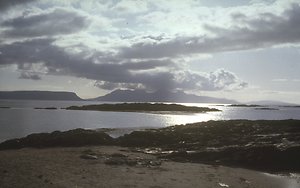
I was used to imagining peoples for whom the sea is no barrier, but a highway between lands and settlements. My task now was to identify my characters’ territory, and to try to envisage it as they did. The coastline has changed shape somewhat, owing to sea level changes in the last 8000 years, but the Auk People’s hunting lands are easily identifiable to those who know them.
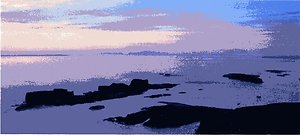
Shortly after publication, I did a reading on Lismore: it may be a clue to other readers to mention that my audience recognised Grandmother Mountain at once. Another clue: the story began to take shape when sailing northwards up the Sound of Mull, out to Ardnmurchan Point, and far into Loch Sunart. Enough: no more clues! Except for this picture of White Beach Island (the White Beach now submerged by sea level rise.)
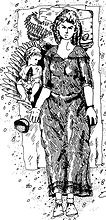
I began to work my way through the dig reports in Glasgow University Library. Instead of answers I found more questions, which grew more specific and intriguing as I went. Why do the Oransay shell middens contain a few knucklebones but no other human remains? Why did the hunters at Starr Carr have a full head mask with deer antlers attached? Why, in Denmark, in a burial of a young woman with her newborn child, was the baby laid on a swan’s wing? (see artist's reconstuction). I read about possible annual migrations through hunting lands: camps along the plentiful sea shores, on small islands, hunting camps in the hills, traces of cave occupations or occasional post holes or charred fireplaces. From these fragments I could began to imagine human lives being lived.
But for a novel one needs a plot: those lives need to be disrupted in some way, so that things can begin to happen. I read that there had been a huge tsunami around 6000BC, resulting from a submarine earthquake off the coast of Norway. The resulting wave swept right down the east coast of Britain. Whoever was living by the North Sea would have had their lives torn apart. I was reading this in the aftermath of the Boxing Day tsunami of 2003; everywhere I turned there were eyewitness accounts of what it had been like.
Mesolithic research was all new territory. The more I read, the more that core of silence confronted me: there were no stories, no voices, no words, no record of any individual. What a change from the C19! I wanted to know what it was like to be these people, but I had no language even to give them names. Clearly I was going to have to fill in gaps, but I wanted to to get my conjectures as accurate as possible. No one had the answers I needed, but the archaeological debate presented plenty of possibilities. I needed an interpreter, ideally a Mesolithic archaeologist who worked in Scotland. The two friends I asked directed me to the same person: Caroline Wickham Jones, based in Orkney.
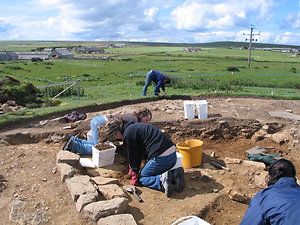
I wrote much of The Gathering Night in Caroline’s welcoming house. I had access to her excellent library, and I volunteered on the dig she was directing at Long Howe (left) in the summer of 2007. On the dig, I had the humble task of sorting gravel. I found a little black chip that didn’t look like stone. I showed it to the 'finds' person, who rushed away with it to the director. To cut a long story short, my unimposing find (below) was a scrap of roasted hazelnut, which, when carbon-dated, extended the known history of Orkney back to around 6000 BC. To the time of my novel in fact; I took this as an excellent omen.
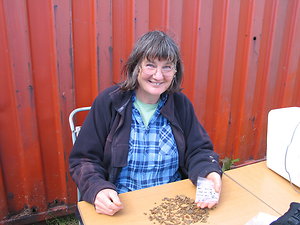
Caroline encouraged me to expand my tentative attempts to fill in the archaeological gaps with ethnographic parallels. Of an evening, I’d say to Caroline, “So how do you think they trapped salmon?” Or, “Do you think they had skin boats like curraghs?” Caroline would find books about fish traps in Tierra del Fuego or Siberia, and show me Mesolithic fish traps excavated in Denmark. Or we’d look at coracles from Wales, Inuit kayaks, and Brazilian dug-out canoes, and discuss which would be best for crossing the Sound of Mull.
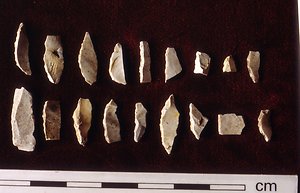
I visited another dig on Coll, directed by Steven Mithen. We were finding microliths which had once been dropped on a beach, now a grassy raised beach. Turning up a Mesolithic microlith is a strange experience: you hold a tiny stone point in the palm of your hand, and you think, “The last person who touched this point is the person who dropped it.” Time isn’t always linear. Someone was here, just where you are, and they held this, just as you hold it now. Their hand is where your hand is: that’s how far away they are.
Anyone who studies hunter gatherer societies comes across a spirituality that is generally described as Shamanistic. I couldn’t use that word, as it is too specific to Siberia. I called my shamanic figures Go-Betweens, as they are the interpreters between People and Spirits, People and Animals. Thinking my way, as far as I could, into my characters’ minds, I found myself in an integrated world, which humans and other beings inhabit seamlessly, without our anxieties about Self and Other, Humanity and Nature, Flesh and Spirit. Life might be short, uncertain, and dangerous, but unlike most of us today, those people belonged on their bit of earth, and they could see the stars.
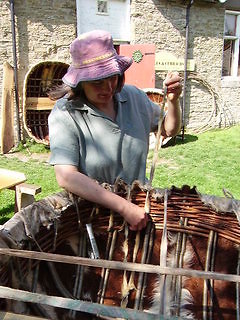
I tried to get to know them by doing the things they did. I had to make up their words as best I could, because none survive, but if I couldn’t use my ears I could use my hands. I made a coracle, learning the feel of hazel wands, willow withies and rawhide, and what I could persuade them to do. My daughter calls the basket I made ‘the Picasso basket’ because it’s on the squint, but it taught me something about willow. I learned to make fire, knap flint (badly), dig for pignuts, and get limpets off rocks. I learned how it feels to paddle a coracle (difficult), and how one feels the water against the oxskin through the soles of one’s feet. I’d never have known that sort of thing if I hadn’t actually done it.
I travelled to all the places in the Auk People’s hunting lands, by land and over sea (not in the coracle) to the islands. Here, for example is the site of Gathering Camp. The Go Between’s Mound has remained uncanny (or holy, depending how you look at it) ever since.
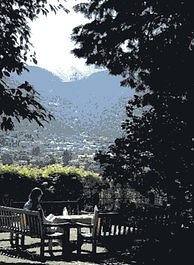
On a completely different note, I also worked on the book while on a residency at Civitella Ranieri, in Umbria. The boar hunt in Chapter Two comes translated almost verbatim from Maurizio Bastianoni, the best hunter in Umbria. It was my good luck that he was the groundsman at the Civitella, as I am not myself a mighty hunter.
I wrote the final section of The Gathering Night while on a Fellowship at the Bellagio Foundation on Lake Como. I hope these two wonderful residencies didn’t make the weather in the Auks’ hunting lands just a little too sunny.
Because our knowledge of the Mesolithic is necessarily fragmentary, and subject to debate, I wondered more than usual what experts would make of my book. I was very happy with a review in Antiquity which made the essential point that whereas archaeologists must take care how they make inferences without evidence, the novelist has to fill in the gaps. One’s characters cannot stand on the shore, and I say “I wonder if we’ll cross the firth in something like a coracle or a curragh, or whether we actually use dugouts. Have we got oars or paddles, and can we possibly have invented a sail yet?” Given the imperative need for decisions, my reviewer kindly said I’d done the homework, and so “Elphinstone’s guess is as good as anyone’s.”
No one knows what it was like here in 6000BC. But there you are: my guess is as good as anyone’s.
Related writing by the author
Margaret Elphinstone has made a number of contributions addrssing connections between archaeology and fiction:
Bill Marshall: Interview with Margaret Elphinstone in Paragraph: Art, Cultural Theory and Modernity Volume 44, Number 3, November 2021 (Edinburgh University Press 2021) pp 394-409
‘Voices From the Silence’ in A Necessary Fiction: Researching the Archaeological Past Through Imagined Narratives Robert Witcher & Daniël Van Helden (Eds.) (London, Routledge 2019) pp 54-69
Archaeology and Fiction in Antiquity Volume 86, Issue 332, June 2012. pp. 532-537
Speaking to the Animals about the Hunt TedX Talk, Findhorn, October 5th 2017
People without maps
Most of my novels have maps and you can view the appropriate map on each page of this website. There’s no map for The Gathering Night. This is partly because sea levels have changed in complicated ways: land around the Scottish ice cap lifted up after the huge weight of ice melted, while sea levels everywhere were also rising. But more importantly, there shouldn’t be a map because my characters imagined their land in other ways.
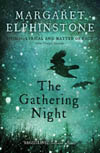
Publication details
The Gathering Night (Edinburgh: Canongate 2009, 2nd ed 2010)
ISBN 9781847672889
Buy The Gathering Night
Published in Canada (Toronto: MacArthur and Co. 2009, 2nd ed 2010)
Translated into Italian as La Notte del Raduno by Carla Palmieri (Einaudi, 2011)
Translated into German as Die Nacht der Jagerinnen by Susanne Aeckerle and Marion Balkenhol (Dumont, 2011)
The Gathering Night reviewed
Independent on Sunday
"This beguiling historical novel imagines the inner and emotional lives of Mesolithic-era humans …… Elphinstone's formidable depiction of nature is the greatest strength of this atmospheric novel."
Read Anita Sethi's review
Toronto Globe & Mail
"...a superbly gripping blend of murder, revenge and incest, which sweeps along with the inexorability of Greek drama."
Read H J Kirchhoff's review
The Sunday Herald
"...a meticulously detailed re-enactment of what life may well have been like in Mesolithic Scotland."
Rebecca McQuillan
The Guardian
"...the most telling achievement of The Gathering Night is that it persuades us to accept its entirely different value-system without a qualm, and even to regret that humanity ever thought of swapping the hunter's spear for the tiller's spade."
Read Adam Thorpe's review
The List
"...gripping in terms of plot...and a hugely evocative exploration of time and place."
Read Doug Johnstone 's review
A book for the armchair traveller
The Gathering Night is featured in a Waterstone's "Armchair Travel" podcast which invites writers to recommend books "which take the reader on a journey". Scottish poet Kathleen Jamie has selected Margaret Elphinstone's ambitious novel which is set some 10,000 years ago in Mesolithic Scotland, describing it as not only a journey through Scotland but also a journey back in time. You can hear from Kathleen in her podcast.
Spotted in Foyles of London - The Gathering Night is a 'Staff Pick'
"I can't understand why Margaret Elphinstone isn't better known - she's a stunning writer with a knack for choosing really interesting themes for her work. This book, set in Mesolithic Scotland, is my favourite ...It's an absorbing, intelligent read, and a vivid and meticulously-researched picture of life in a time unimaginably distant from ours."



